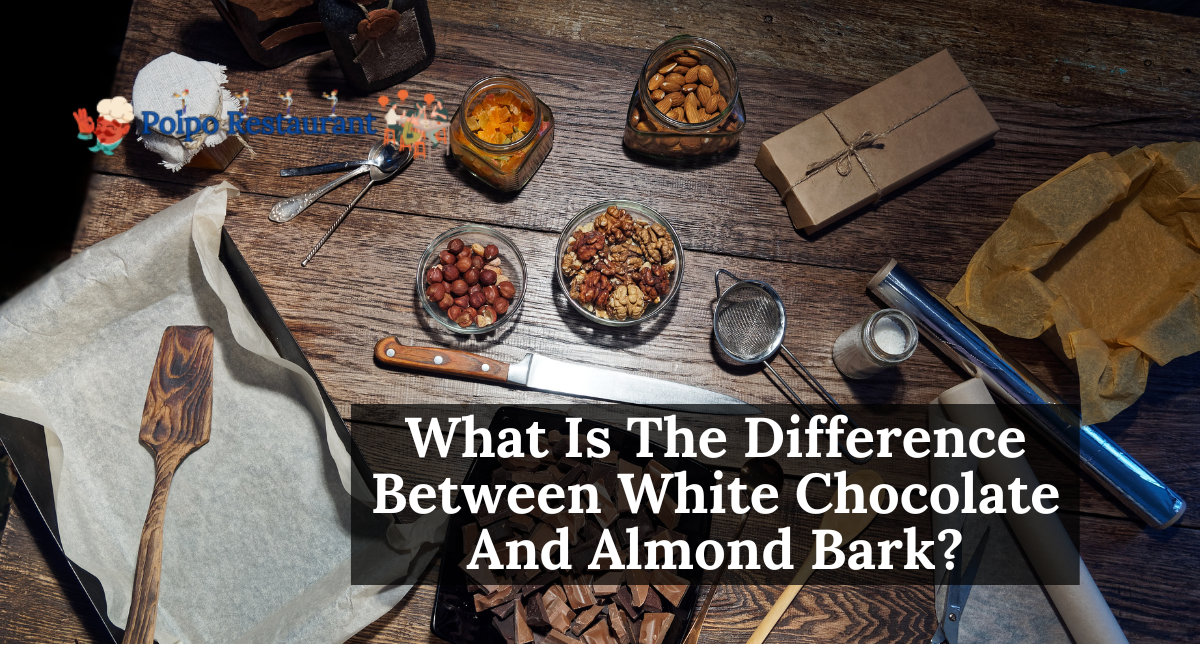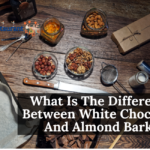White chocolate and almond bark are frequently used in desserts, confections, and baking, adding a delightful touch to various delights. While they share similarities in appearance and application, their composition, flavor, and uses are distinct. Understanding these distinctions is essential for creating dishes with the intended flavors and textures.
This article will compare and contrast white chocolate and almond bark regarding their ingredients, production procedures, flavor profiles, and best culinary and baking applications.
What Is The Difference Between White Chocolate And Almond Bark?
Now that you know everything about almond bark and white chocolate, it is time to delve deeper! Following are four important distinctions between almond bark and white chocolate.
- They have distinct constituents: Ingredients are the primary distinction between almond bark and white chocolate. As indicated previously, white chocolate is composed of scale majoritatea. The almond bark contains no cocoa residue. However, they remain interchangeable due to their similarity; baking is strange.
- Almond husk melts more quickly: You may fret if your recipe calls for white chocolate. When it comes to melting, white chocolate is somewhat temperamental, and many things can go awry. The superior choice? Employ almond husk. Due to its composition of vegetable lipids and other additives, it melts quickly, even in the microwave.
- White chocolate is more velvety and creamy: When you bite into a piece of white chocolate, you are immediately met with an undeniably desirable creamy texture. It is so incredibly smooth that it is like soaking in white chocolate.
- White chocolate is more decadent: In addition to its velvety consistency, white chocolate is renowned for its exquisite richness. Biting into a piece of white chocolate can feel like perpetrating a culinary sin. It is perfectly acceptable to indulge in this delicious chocolate, however. Almond bark is typically less dense and on the leaner side. This is due to the components used to create almond husk. With no cocoa, it lacks the delightful richness of white chocolate (and other chocolates).
What exactly Is Almond Bark?
Before discussing the similarities and differences between these two premium ingredients, it is necessary to define them.
Although almond bark is available in white and chocolate varieties, it contains no cacao. Instead, it is made with vegetable lipids and various flavorings and colorings. Due to the absence of cocoa, the texture and flavor could be more velvety and robust. However, it is much simpler to dissolve.
What Constitutes White Chocolate?
White chocolate, on the other hand, is composed of cocoa butter and a few additional ingredients, including milk products and vanilla. White chocolate’s legitimacy as “chocolate” is widely debated. In the past, for a delicacy to be considered “real chocolate,” it was necessary for it to contain cocoa solids of some kind.
The rules have changed, however. White chocolate has been included under the category of “real chocolate.” If the product contains at least 20 percent cocoa butter, it can be called “real chocolate.”
Whether authentic or not, white chocolate is luxurious, silky, and delectable. This is my favorite chocolate because it has a delightful flavor. White chocolate can be challenging to soften, so many prefer almond bark.
Is White Chocolate Interchangeable With Almond Bark?
White chocolate can be substituted for almond bark in nearly all recipes. Many individuals favor almond bark over white chocolate, particularly when it comes to melting.
Because almond bark is considerably simpler to melt than white chocolate, you won’t have to fret about the nuances that can instantly ruin white chocolate.
White chocolate is the best choice in recipes where the white chocolate does not need to be melted, such as in some cheesecakes and other treats. White chocolate is more luscious and creamy, desirable in certain delectable delicacies.
Which Is Superior: Almond Coating Or White Chocolate?
Your choice between almond bark and white chocolate will depend on your specific requirements, preferences, and intended application. Here is a comparison to help you make a decision:
Almond Bark
- Pros: The almond coating is frequently more affordable than white chocolate. Almond bark readily melts and solidifies, making it suitable for various recipes. It can be used for coating, dipping, molding, or sprinkling over confections.
- Stability: The composition of almond bark is more stable, making it less susceptible to seizing or scorching during dissolving.
- Cons: Almond bark typically contains vegetable oils rather than cocoa butter, so it lacks an authentic chocolate flavor. It may have lower cocoa content and fewer health benefits compared to genuine chocolate.
White Chocolate
- Pros: White chocolate has a genuine cocoa butter flavor, offering a richer and more authentic chocolate experience.
- Authentic Flavor: It comprises cocoa butter, sugar, milk solids, and vanilla, giving it a more traditional chocolate taste. When consumed in moderation, white chocolate can provide specific health benefits, such as calcium from milk solids.
- Cons: Pure white chocolate produced with premium ingredients is typically more expensive. White chocolate can be more sensitive to temperature fluctuations during melting, necessitating cautious handling to prevent seizing.
White Chocolate And Almond Bark Are Similar But Not Identical
Almond bark and white chocolate are frequently used interchangeably but are not identical. White chocolate contains cocoa butter, creating a luxurious and velvety product, whereas almond bark is made with vegetable fats and is more straightforward to melt.
White chocolate and almond bark may appear similar, but there are significant distinctions between them. The cocoa butter in white chocolate gives it a creamier texture and authentic chocolate flavor. In contrast, almond bark is typically produced from vegetable fats and lacks a distinct chocolate flavor. Depending on your recipe and desired outcome, selecting the proper one can substantially impact the taste and texture of your confections.
Thanks for reading.










